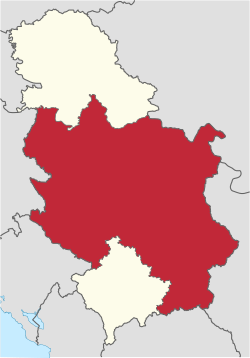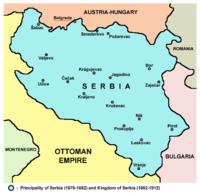Central Serbia
Central Serbia | |
|---|---|
 Map of Central Serbia within Serbia | |
| Largest city | Belgrade |
| Area | |
• Total | 55,968 km2 (21,609 sq mi) |
| Population | |
• 2022 census | 4,906,773 |
• Density | 87.6/km2 (226.9/sq mi) |
| Time zone | UTC+1 (CET) |
• Summer (DST) | UTC+2 (CEST) |
Central Serbia (
Broadly speaking, Central Serbia is the historical core of modern Serbia, which emerged from the Serbian Revolution (1804–17) and subsequent wars against the Ottoman Empire. In the following century, Serbia gradually expanded south, acquiring South Serbia, Kosovo, Sandžak and Vardar Macedonia, and in 1918 – following the unification and annexation of Montenegro and unification of Austro-Hungarian areas left of the Danube and Sava (Vojvodina) – it merged with other South Slavic territories into the Kingdom of Yugoslavia. The current borders of Central Serbia were defined after World War II, when Serbia became a republic within the Socialist Federal Republic of Yugoslavia, with Kosovo and Vojvodina as its autonomous provinces.
Geography
Central Serbia takes up, roughly, the territory of Serbia between the natural borders consisting of the Danube and Sava (in the north), the Drina (in the west), and the "unnatural" border to the southwest with Montenegro, south with Kosovo and North Macedonia, and to the east with Bulgaria, with a small strip of the Danube with Romania in the northeast. The Danube and Sava divides central Serbia from the Serbian province of Vojvodina, while the Drina divides Serbia from Bosnia and Herzegovina. The Great Morava, a major river, goes through central Serbia. Extensions of three major mountain chains are located within Serbia proper: Dinaric Alps in the west and south, and the Carpathians and Balkan Mountains in the east.
Some notable geographical regions located in central Serbia are:
.History


In the
Between 1718 and 1739, the Sanjak of Smederevo was occupied by the
In the
Between 1941 and 1944, most of the territory was part of the area governed by the
The Axis occupation ended in 1944 with the liberation of Yugoslavia by the
With the formation of new statistical regions of Serbia in 2009–10, three statistical regions: Belgrade, Šumadija and Western Serbia and Southern and Eastern Serbia form Central Serbia.[1]
Administrative divisions

| District | Area (km2) | Population (2011) |
Seat |
|---|---|---|---|
| Belgrade | |||
| 3,227 | 1,659,440 | ||
| Belgrade | 3,227 | 1,659,440 | Belgrade |
| Šumadija and Western Serbia | |||
| 26,483 | 2,062,945 | ||
| Mačva | 3,264 | 298,931 | Šabac |
| Kolubara | 2,474 | 174,513 | Valjevo |
| Moravica | 3,016 | 212,603 | Čačak |
| Zlatibor | 6,142 | 286,549 | Užice |
| Šumadija | 2,387 | 293,308 | Kragujevac |
| Pomoravlje | 2,614 | 214,536 | Jagodina |
| Raška | 3,922 | 309,258 | Kraljevo |
| Rasina | 2,664 | 273,247 | Kruševac |
| Southern and Eastern Serbia | |||
| 26,255 | 1,563,916 | ||
| Podunavlje | 1,250 | 199,395 | Smederevo |
| Braničevo | 3,865 | 183,625 | Požarevac |
| Bor | 3,510 | 124,992 | Bor |
| Zaječar | 3,623 | 119,967 | Zaječar |
| Nišava | 2,727 | 376,319 | Niš |
| Pirot | 2,761 | 92,479 | Pirot |
| Toplica | 2,229 | 91,754 | Prokuplje |
| Jablanica | 2,770 | 216,304 | Leskovac |
| Pčinja | 3,520 | 159,081 | Vranje |
| 55,965 | 5,286,301 | ||
Demographics
Ethnic groups of Central Serbia according to the 2022 census:
- Serbs: 4,169,454 (84.97%)
- Bosniaks: 153,083 (3.12%)
- Romani: 90,998 (1.85%)
- Albanians: 59,752 (1.22%)
- Vlachs: 20,828 (0.42%)
- ethnic Muslims: 10,592 (0.23%)
- Bulgarians: 11,795 (0.24)
- Montenegrins: 7,814 (0.15%)
- Croats: 6,423 (0.13%)
- Yugoslavs: 14,705 (0.30%)
- Macedonians (ethnic group) 7,746 (0.15%)
In 2022, most of the municipalities of Central Serbia had an ethnic Serb majority, three municipalities (Novi Pazar, Tutin, and Sjenica) had a Bosniak majority, two municipalities (Bujanovac and Preševo) had an Albanian majority and two municipalities (Bosilegrad and Dimitrovgrad) had a Bulgarian majority.[2]
See also
Annotations
- ^ Besides the name "Central Serbia", the term "Serbia proper" was also used in English to refer to the region. "Serbia proper" is simply an English translation of the Serbian term Uža Srbija (Ужа Србија), which was used as a name of the region during the existence of the Socialist Federal Republic of Yugoslavia; the term was controversial and, due to that, Serbian government publications used Centralna Srbija (Централна Србија, "Central Serbia") instead. The term Uža Srbija was rejected because it implied a distinction between Serbia and its autonomous provinces. According to the Library of Congress, "Serbia Proper" denoted "the part of the Republic of Serbia not including the provinces of Vojvodina and Kosovo; the ethnic and political core of the Serbian state."[3]
References
Notes
References
- ISBN 978-86-6161-109-4. Retrieved 2014-06-27.
- ^ "Попис становништва, домаћинстава и станова 2011. у Републици Србији" (PDF). stat.gov.rs. Republički zavod za statistiku. Archived from the original (PDF) on 11 August 2014. Retrieved 2 June 2015.
- ^ The Library of the Congress. Glossary - Yugoslavia.
